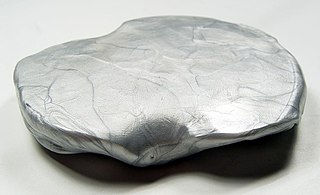
Silly Putty is a toy containing silicone polymers that have unusual physical properties. It can flow like a liquid, bounce, stretch, or break depending on the amount of physical stress to which it is subjected. It contains viscoelastic liquid silicones, a type of non-Newtonian fluid, which makes it act as a viscous liquid over a long time period but as an elastic solid over a short time period. It was originally created during research into potential rubber substitutes for use by the United States in World War II.

Linseed oil, also known as flaxseed oil or flax oil, is a colourless to yellowish oil obtained from the dried, ripened seeds of the flax plant. The oil is obtained by pressing, sometimes followed by solvent extraction.

Putty is a material with high plasticity, similar in texture to clay or dough, typically used in domestic construction and repair as a sealant or filler. Although some types of putty slowly polymerise and become stiff, many putties can be reworked indefinitely, in contrast to other types of filler which typically set solid relatively rapidly.

Tin(IV) oxide, also known as stannic oxide, is the inorganic compound with the formula SnO2. The mineral form of SnO2 is called cassiterite, and this is the main ore of tin. With many other names, this oxide of tin is an important material in tin chemistry. It is a colourless, diamagnetic, amphoteric solid.

(The) Putty Road is a 168-kilometre (104 mi)-long rural road that links the Hunter Region in New South Wales to Wilberforce, just north of Windsor on the far northwestern suburban edge of Sydney, Australia.
John or Jack Nicholls may refer to:

Lime mortar or torching is a masonry mortar composed of lime and an aggregate such as sand, mixed with water. It is one of the oldest known types of mortar, used in ancient Rome and Greece, when it largely replaced the clay and gypsum mortars common to ancient Egyptian construction.
A spatula is a cooking utensil.
John E. Jones may refer to:
John Edward Jones may refer to:
Putti are chubby male infants in classical painting.
This page is based on this
Wikipedia article Text is available under the
CC BY-SA 4.0 license; additional terms may apply.
Images, videos and audio are available under their respective licenses.





